(2187 products available)


















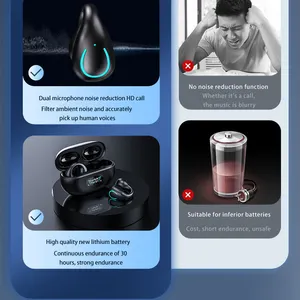

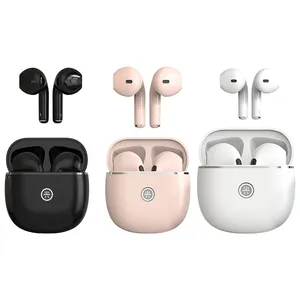












































































































































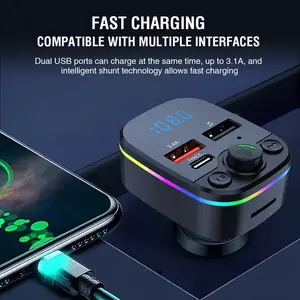










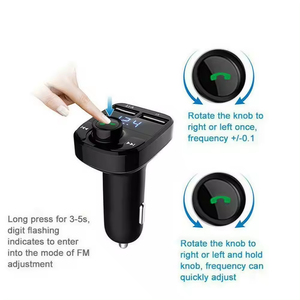
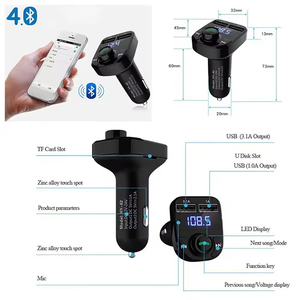
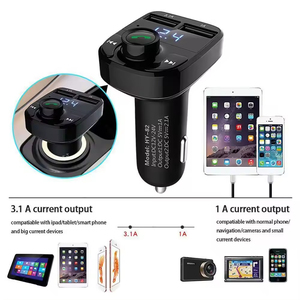

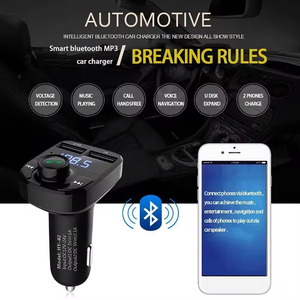






























A hands-free Bluetooth car kit allows drivers to make and receive phone calls while driving without using their hands. The kit connects to the car's sound system through Bluetooth, allowing the driver to talk through the car's speakers and microphones. This system minimizes distractions, ensuring the driver's focus remains on the road. Various types of hands-free Bluetooth car kits are available to cater to specific customer needs.
Bluetooth Car Speakerphones
Bluetooth car speakerphones are created for safe and convenient communication while driving. They connect to the car's audio system through Bluetooth, enabling drivers to make and receive calls without using their hands. The kits often have voice recognition, allowing users to initiate calls by speaking a contact's name. Additionally, they usually have noise cancellation and echo reduction technologies, ensuring clear conversations even at high speeds. Some advanced models integrate with a car's navigation system to provide turn-by-turn directions over the speakerphone.
Bluetooth FM Transmitters
Bluetooth FM transmitters are small devices that allow users to stream audio from their phones to their car's radio over an FM frequency. They are particularly useful for older car models without built-in Bluetooth. Beyond hands-free calling, they enable drivers to listen to music, podcasts, and other audio content from their phones. Many Bluetooth FM transmitters have additional features, such as USB ports for phone charging, auxiliary ports for wired connections, and built-in microphones for clear call quality.
Bluetooth Car Adapters
Bluetooth car kits are designed to upgrade existing car audio systems. They connect to the car's auxiliary port or cigarette lighter socket, enabling Bluetooth functionality. This allows users to stream audio from their smartphones to the car's audio system. Some Bluetooth car kits come with built-in microphones, enabling hands-free calling. Others may include additional features such as noise cancellation, voice command capabilities, and multi-device pairing, allowing simultaneous connections to multiple devices.
Built-in Bluetooth
Some modern cars come with a hands-free Bluetooth system installed. Drivers should check their car manuals to see whether their cars already have Bluetooth capabilities. If the car is already equipped with Bluetooth, the driver can connect their phone to the car's audio system and make calls using the voice controls. This system allows users to make calls through the car's interface, ensuring their hands stay on the wheel and eyes on the road.
Bluetooth specifications are technical standards that describe the capabilities of Bluetooth technology. Bluetooth was developed in the 1990s by a group of engineers working for a Norwegian telecommunications company, Telenor. The group was researching a way to connect mobile phones to the Internet without using wires. They called it ""Bluetooth"" after the 10th-century Danish king Harald ""Bluetooth,"" who united Denmark and Norway.
Technology continued to evolve, and Bluetooth was officially introduced in 1998. The Bluetooth Special Interest Group (SIG) was formed to oversee its development. The group consisted of several companies, including Intel, Ericsson, Nokia, and IBM. Bluetooth was first used in wireless headsets for mobile phones. Over the years, it has become a standard for connecting devices wirelessly in many applications, including car kits. The hands-free Bluetooth car kit has a long history since its inception.
Specifications will help one understand how to maintain Bluetooth technology in a hands-free device.
Maintaining a Bluetooth device involves keeping it clean and dry. Moisture and liquids can damage electronic components, so keeping the device away from moisture, rain, or splashes is essential. Dust, dirt, and grime can accumulate on Bluetooth devices, affecting their performance over time. Gently cleaning the device with a soft, dry cloth or removing any visible dirt or debris is essential. Users can use mild cleaners designed for electronics to remove stubborn stains.
One should update their device software regularly. Manufacturers frequently release updates to Bluetooth devices to fix bugs, improve performance, and add features. These updates may enhance compatibility with other devices and improve overall performance. Check the manufacturer's website or use their provided update tool regularly to ensure the device runs the latest software version.
Another way to maintain Bluetooth devices is to ensure that Bluetooth is activated when needed. Keeping Bluetooth enabled on a device drains the battery faster, even if it is not actively connected to anything. Turn off Bluetooth when not in use to conserve battery life. Disconnecting unnecessary connections can improve Bluetooth performance and protect sensitive data from unauthorized access.
Over time, the battery in a Bluetooth device may degrade and hold less charge. Replacing the battery when one notices a significant reduction in battery life or performance is essential. Follow the manufacturer's instructions or seek professional assistance when replacing the battery.
Considering the following aspects before purchasing a Bluetooth car kit for hands-free will help ensure the product meets the required standards and is worth the investment.
Sound Quality
When selecting a hands-free Bluetooth car kit, sound quality should be prioritized. One with noise cancellation and sound enhancement features ought to be chosen. The gadget should be able to deliver clear phone calls without interruptions from background noise. It ought to have balanced audio performance in order to provide a satisfying listening experience when playing music.
Microphone Quality
Another important aspect to consider is the quality of the microphone. A hands-free car kit with a high-quality microphone should be chosen. One with noise-canceling capabilities that can filter out background and road noise is required. The microphone's placement within the kit is also important since it affects how well it picks up the user's voice. To ensure clear communication during calls, a microphone should be placed to optimally capture the user's voice while minimizing ambient noise.
Ease of Use
Ease of use is crucial when selecting a Bluetooth kit for hands-free operation in a car. A kit with simple controls for making and receiving calls should be selected. Voice control capabilities are also desirable since they allow for hands-free operation, reducing the need to fiddle with buttons while driving. Moreover, the kit's installation should be simple and quick, requiring no complicated setup or additional tools.
Compatibility
Compatibility is essential when selecting a Bluetooth kit for hands-free operation in a car. One should be chosen that is compatible with the user's smartphone's operating system. Whether Android or iOS, the kit should support seamless integration and a stable Bluetooth connection. Furthermore, the kit should support various audio codecs to ensure compatibility with different devices and deliver optimal audio quality.
Audio Quality
Audio quality is also vital when selecting a Bluetooth kit for hands-free operation in a car. A kit that supports high-definition audio streaming should be selected to ensure clear and crisp sound during music playback and calls. Features such as equalizers and customizable audio settings should also be included in the kit to allow users to tailor the audio performance to their tastes.
Installation and Setup
Installation and setup is an important aspect when selecting a Bluetooth kit for hands-free operation in a car. A kit with straightforward and fast installation should be selected, requiring no extra tools or complicated procedures. Furthermore, the setup of the kit should be simple and intuitive, with clear instructions and simple controls for pairing with a smartphone and configuring various settings.
Safety Features
Safety features are important when selecting a Bluetooth kit for hands-free operation in a car. The kit should have features such as voice control, allowing users to operate it without taking their hands off the wheel or their eyes off the road. Furthermore, the kit should have an intuitive interface and clear visual prompts to minimize distraction while driving.
Battery Life
Battery life is crucial when selecting a Bluetooth kit for hands-free operation in a car. A kit with extended battery life should be selected, allowing prolonged use without frequent charging. Moreover, the kit should have fast charging capabilities or convenient charging options to ensure it is always charged and ready for use.
For those who are tech-savvy and want to save some money, installing a hands-free Bluetooth car kit can be a DIY project. Generally, the installation process is straightforward, and detailed instructions are provided in the user manual. Here are the basic steps to install a Bluetooth car kit.
Preparation
Gather all necessary tools for the installation process. These may include screwdrivers, trim removal tools, and electrical tape. Ensure that the car battery is turned off to avoid any electrical short circuits or damage to the car's electrical system.
Remove Trim
Using the trim removal tools, gently remove the trim pieces surrounding the car stereo or the area where the Bluetooth kit will be installed. Be cautious not to damage the trim or the surrounding areas.
Connect the Car Kit to Power
Find the car's power wires, usually located behind the stereo. Connect the hands-free Bluetooth car kit wires to the car's power wires. Ensure the connections are secure and insulated to prevent any electrical short circuits.
Connect to the Audio System
Depending on the type of car kit, connect it to the car's audio system through the auxiliary port, FM transmitter, or direct wiring. Follow the manufacturer's instructions for the specific connection method.
Mount the Microphone
Mount the microphone as per the manufacturer's instructions. Typically, the microphone is mounted on the steering column or near the rearview mirror. Route the microphone wire through the trim and connect it to the Bluetooth car kit.
Finalize Installation
Double-check all connections to ensure they are secure. Reattach the trim pieces and any other components that were removed during the installation process. Turn on the car's power and test the Bluetooth car kit to ensure it is functioning correctly.
Q1: What is a Bluetooth car kit?
A1: A Bluetooth car kit is an accessory that allows users to connect their car audio system to their mobile devices via Bluetooth. This enables hands-free calling, voice navigation, and wireless music streaming, enhancing driving safety and convenience.
Q2: What is a Bluetooth FM transmitter?
A2: A Bluetooth FM transmitter is a device that connects to a car's FM radio and transmits audio signals over a frequency, allowing users to tune in to a specific FM channel. It converts Bluetooth audio from mobile devices into FM signals, enabling wireless music streaming on older car radios that lack Bluetooth capabilities.
Q3: Does a hands-free car kit work with all phones?
A3: Generally, a hands-free car kit should work with all Bluetooth-enabled phones. However, some advanced features might be optimized for specific operating systems, like Android or iOS.
Q4: Are car Bluetooth adapters safe?
A4: Yes, car Bluetooth adapters are safe. They are designed to not interfere with car operations. However, like all electronic devices, they should be used per the manufacturer's instructions to ensure optimal performance and safety.